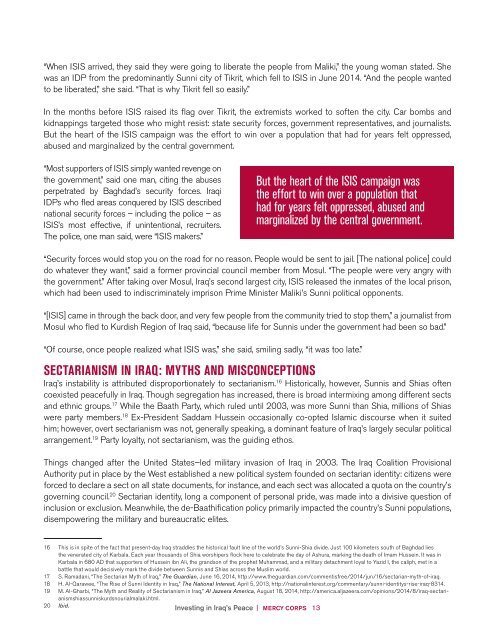INVESTING IN IRAQ’S PEACE
Investing%20in%20Iraqs%20Peace_Final%20Report
Investing%20in%20Iraqs%20Peace_Final%20Report
Create successful ePaper yourself
Turn your PDF publications into a flip-book with our unique Google optimized e-Paper software.
“When ISIS arrived, they said they were going to liberate the people from Maliki,” the young woman stated. She<br />
was an IDP from the predominantly Sunni city of Tikrit, which fell to ISIS in June 2014. “And the people wanted<br />
to be liberated,” she said. “That is why Tikrit fell so easily.”<br />
In the months before ISIS raised its flag over Tikrit, the extremists worked to soften the city. Car bombs and<br />
kidnappings targeted those who might resist: state security forces, government representatives, and journalists.<br />
But the heart of the ISIS campaign was the effort to win over a population that had for years felt oppressed,<br />
abused and marginalized by the central government.<br />
“Most supporters of ISIS simply wanted revenge on<br />
the government,” said one man, citing the abuses<br />
perpetrated by Baghdad’s security forces. Iraqi<br />
IDPs who fled areas conquered by ISIS described<br />
national security forces – including the police – as<br />
ISIS’s most effective, if unintentional, recruiters.<br />
The police, one man said, were “ISIS makers.”<br />
But the heart of the ISIS campaign was<br />
the effort to win over a population that<br />
had for years felt oppressed, abused and<br />
marginalized by the central government.<br />
“Security forces would stop you on the road for no reason. People would be sent to jail. [The national police] could<br />
do whatever they want,” said a former provincial council member from Mosul. “The people were very angry with<br />
the government.” After taking over Mosul, Iraq’s second largest city, ISIS released the inmates of the local prison,<br />
which had been used to indiscriminately imprison Prime Minister Maliki’s Sunni political opponents.<br />
“[ISIS] came in through the back door, and very few people from the community tried to stop them,” a journalist from<br />
Mosul who fled to Kurdish Region of Iraq said, “because life for Sunnis under the government had been so bad.”<br />
“Of course, once people realized what ISIS was,” she said, smiling sadly, “it was too late.”<br />
SECTARIANISM <strong>IN</strong> IRAQ: MYTHS AND MISCONCEPTIONS<br />
Iraq’s instability is attributed disproportionately to sectarianism. 16 Historically, however, Sunnis and Shias often<br />
coexisted peacefully in Iraq. Though segregation has increased, there is broad intermixing among different sects<br />
and ethnic groups. 17 While the Baath Party, which ruled until 2003, was more Sunni than Shia, millions of Shias<br />
were party members. 18 Ex-President Saddam Hussein occasionally co-opted Islamic discourse when it suited<br />
him; however, overt sectarianism was not, generally speaking, a dominant feature of Iraq’s largely secular political<br />
arrangement. 19 Party loyalty, not sectarianism, was the guiding ethos.<br />
Things changed after the United States–led military invasion of Iraq in 2003. The Iraq Coalition Provisional<br />
Authority put in place by the West established a new political system founded on sectarian identity: citizens were<br />
forced to declare a sect on all state documents, for instance, and each sect was allocated a quota on the country’s<br />
governing council. 20 Sectarian identity, long a component of personal pride, was made into a divisive question of<br />
inclusion or exclusion. Meanwhile, the de-Baathification policy primarily impacted the country’s Sunni populations,<br />
disempowering the military and bureaucratic elites.<br />
16 This is in spite of the fact that present-day Iraq straddles the historical fault line of the world’s Sunni-Shia divide. Just 100 kilometers south of Baghdad lies<br />
the venerated city of Karbala. Each year thousands of Shia worshipers flock here to celebrate the day of Ashura, marking the death of Imam Hussein. It was in<br />
Karbala in 680 AD that supporters of Hussein ibn Ali, the grandson of the prophet Muhammad, and a military detachment loyal to Yazid I, the caliph, met in a<br />
battle that would decisively mark the divide between Sunnis and Shias across the Muslim world.<br />
17 S. Ramadani, “The Sectarian Myth of Iraq,” The Guardian, June 16, 2014, http://www.theguardian.com/commentisfree/2014/jun/16/sectarian-myth-of-iraq.<br />
18 H. Al-Qarawee, “The Rise of Sunni Identity in Iraq,” The National Interest, April 5, 2013, http://nationalinterest.org/commentary/sunni-identitys-rise-iraq-8314.<br />
19 M. Al-Gharbi, “The Myth and Reality of Sectarianism in Iraq,” Al Jazeera America, August 18, 2014, http://america.aljazeera.com/opinions/2014/8/iraq-sectarianismshiassunniskurdsnourialmalaki.html.<br />
20 Ibid.<br />
Investing in Iraq’s Peace | MERCY CORPS 13


